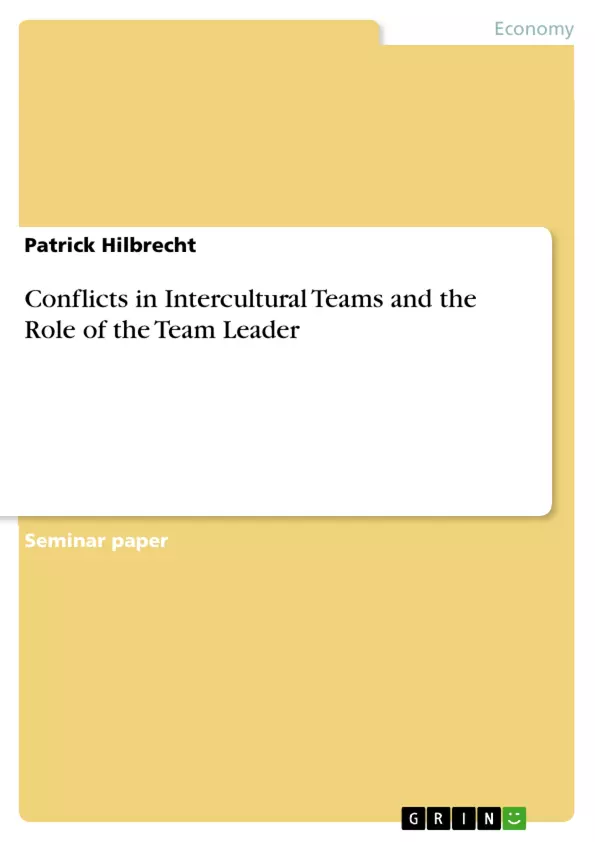This term paper aims to point out where the challenges of intercultural teams lie and how these can be met accordingly. The problem is going to be approached by using the management’s perspective. Firstly, there will be explained how culture can be defined. Next to that, possible cultural differences will be explained by making use of Hofstede´s Five Cultural Dimensions. Through this there shall be outlined where potential fields of conflict can lie between different cultures. Hereafter, the term paper is going to point out, where the benefits of an intercultural team lie, in order to generate a better understanding of the necessity to develop appropriate management competencies. Next to that, potential fields of conflict will be explained that exist in an intercultural team and that ought to be prevented. Therefore the critical success factors of an intercultural team will be outlined with special focus on the role of the team leader of an intercultural team.
Due to globalisation companies nowadays find themselves in an international working environment. This is the fact considering business relationships with external partners, but the internationalization can also be found within the companies. The working environment is not only characterized though a higher complexity but also through international and intercultural teams.
On the one hand, this circumstance holds many potentials from which a company can benefit. On the other hand, it can also be challenging though, as management can also be confronted with problems arising from a clash of cultures in multinational teams. The potential for conflict can lie in the different understandings of morals and values, but also in communication problems. In order to meet these challenges, intercultural competencies have become an important skill for team leaders in companies that operate internationally.
Inhaltsverzeichnis (Table of Contents)
- 1. Introduction
- 2. Culture
- 3. Hofstede's Cultural Dimensions
- 3.1. Power Distance
- 3.2. Individualism vs. Collectivism
- 3.3. Masculinity vs. Femininity
- 3.4. Uncertainty Avoidance
- 3.5. Long-Term Orientation vs. Short-Term Orientation
- 4. Intercultural Teams
- 4.1. Advantages of Intercultural Teams
- 4.2. Disadvantages of Intercultural Teams
- 4.3. Critical Success Factors of an Intercultural Team
- 4.4. The role of the team leader
- 5. Resumé
Zielsetzung und Themenschwerpunkte (Objectives and Key Themes)
This paper investigates the challenges of managing intercultural teams within a globalized business environment. The focus is on understanding the potential for conflict arising from cultural differences and developing effective management strategies to overcome these challenges. The management perspective is adopted throughout the paper.
- Defining and understanding cultural differences.
- Exploring Hofstede's Cultural Dimensions and their implications for intercultural teams.
- Identifying the advantages and disadvantages of intercultural teams.
- Analyzing the critical success factors for effectively managing intercultural teams.
- Examining the role of the team leader in facilitating successful intercultural teamwork.
Zusammenfassung der Kapitel (Chapter Summaries)
- Chapter 1: Introduction This chapter introduces the topic of intercultural teams in the context of globalization and the increasing importance of international business. It highlights the potential benefits and challenges associated with working in culturally diverse teams, emphasizing the need for intercultural competence among team leaders.
- Chapter 2: Culture This chapter explores the concept of culture as defined by Hofstede, focusing on the idea of culture as a "software of the mind" that shapes individuals' values, beliefs, and behaviors. The chapter discusses how these cultural values are formed during childhood and influence individuals' perspectives and ways of thinking.
- Chapter 3: Hofstede's Cultural Dimensions This chapter examines the five cultural dimensions identified by Geert Hofstede - power distance, individualism vs. collectivism, masculinity vs. femininity, uncertainty avoidance, and long-term orientation vs. short-term orientation. Each dimension is explained in detail, highlighting the differences between cultures based on these dimensions and their potential impact on intercultural team dynamics.
- Chapter 4: Intercultural Teams This chapter delves into the advantages and disadvantages of intercultural teams. It analyzes the benefits of having a diverse range of perspectives and experiences within a team while also acknowledging the challenges that can arise from cultural differences, such as communication misunderstandings and conflict resolution issues.
Schlüsselwörter (Keywords)
This paper focuses on the challenges and opportunities of intercultural teams in a globalized business environment. Key concepts include Hofstede's Cultural Dimensions, power distance, individualism vs. collectivism, cultural differences, communication barriers, conflict resolution, team leadership, intercultural competence, and effective management strategies for navigating cultural diversity within teams.
- Arbeit zitieren
- Patrick Hilbrecht (Autor:in), 2016, Conflicts in Intercultural Teams and the Role of the Team Leader, München, GRIN Verlag, https://www.grin.com/document/584864



